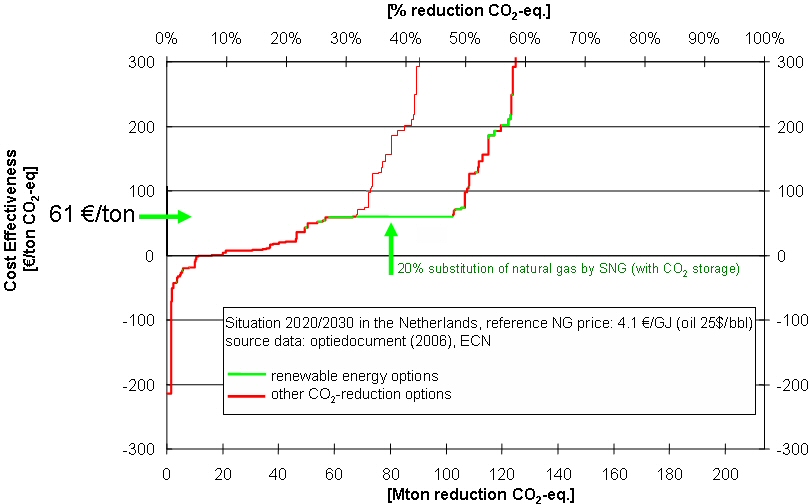Competitiveness
As initially the costs of bioSNG will be higher then the natural gas price bioSNG will have to rely on financial incentives from the government, e.g. tax exemptions or binding targets for the share of biofuels in our energy consumption. As such, it will have to compete with alternative technologies that result in the reduction of greenhouse gas emissions.
In February 2006, ECN Policy Studies and MNP published the Dutch "Optiedocument" [1], with the results of the assessment of potential and cost consequences to reduce Dutch greenhouse gas emissions in 2020 and to assess the potential and costs of increasing the rate of energy efficiency improvement between 2010 and 2020. Over 150 measures to limit emissions and energy consumption have been assessed. The measures have been combined and ranked based on minimising the national costs of emission reduction.
It appeared that the identified measures can be combined to represent a technical emission reduction potential of 90 Mton CO2 eq emissions in 2020, whereby costs of CO2 emission reduction increased going from road pricing (below zero) via nuclear power (~10 €/ton) and offshore wind (~60 €/ton) to even the first 2nd generation biofuels and upgraded biogas (> 200 €/ton). A graph was created showing the CO2 emission reduction costs as a function of the amount of CO2 reduction that could be realised. This graph is presented as the thin red line in the figure below. In a cost minimizing package to limit emissions, the largest contribution have to come from energy savings followed by CO2 capture and storage and nuclear energy. It must be noted that the feasibility and availability of policy instruments to overcome the barriers to implement these measures had not been studied or taken into account.

Even taking into account very expensive technologies the emission can only be reduced with roughly 40%. One of the main reasons for this is the fact that almost all technologies aim at the substitution of electricity or transport fuels, and not on the substitution of heat (i.e. mainly natural gas). Roughly 40% of all CO2 equivalent emissions are related to natural gas. Substituting natural gas by bioSNG can hence have a significant influence on the reduction of the CO2 equivalent emissions.
In the figure above the effect of 20% substitution of natural gas with bioSNG is illustrated. Considering production costs of the bioSNG of 10.5 €/GJ and a reference cost of natural gas of 4.1 €/GJ (in accordance to the "onrendabele top" method used by ECN Policy Studies) the cost effectiveness of bioSNG would be around 115 €/ton CO2 equivalent, or even 61 €/ton when storage of the already within the process captured CO2 is taken into acount.
As a result bioSNG is a product that can already compete with other renewable technologies already being implemented (e.g. offshore wind) and enables the reduction of far more then 40% of the CO2 equivalent emissions in the Netherlands (in potential even up to 80%).
References:
B.W. Daniëls, L.W.M. Beurskens, Y.H.A. Boerakker, H.C. de Coninck, A.W.N. van Dril, R. Harmsen, H. Jeeninga, P. Kroon, P. Lako, H.M. Londo, M. Menkveld, A.J. Seebregts, G.J. Stienstra, C.H. Volkers, H.J. de Vries, J.R. Ybema, and J.C.M. Farla: Verkenning klimaatdoelstellingen en energiebesparing 2020. Analyses met het Optiedocument energie en emissies 2005. (Dutch) ECN, ECN-C--05-106, 2006, pp. 63